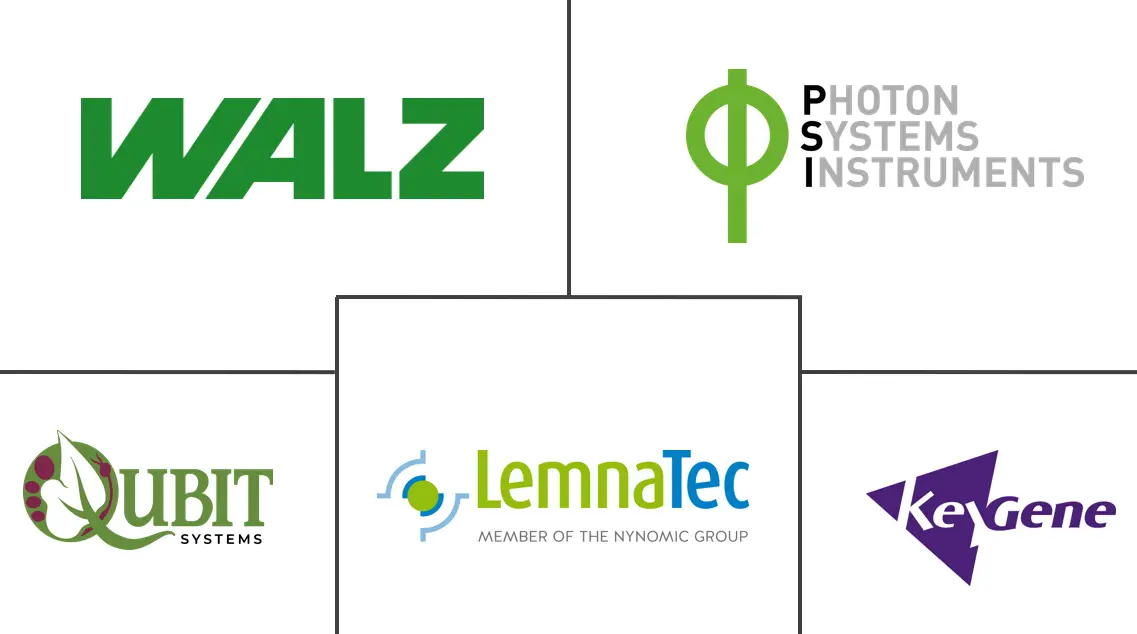Plant Phenotyping Market Size and Share
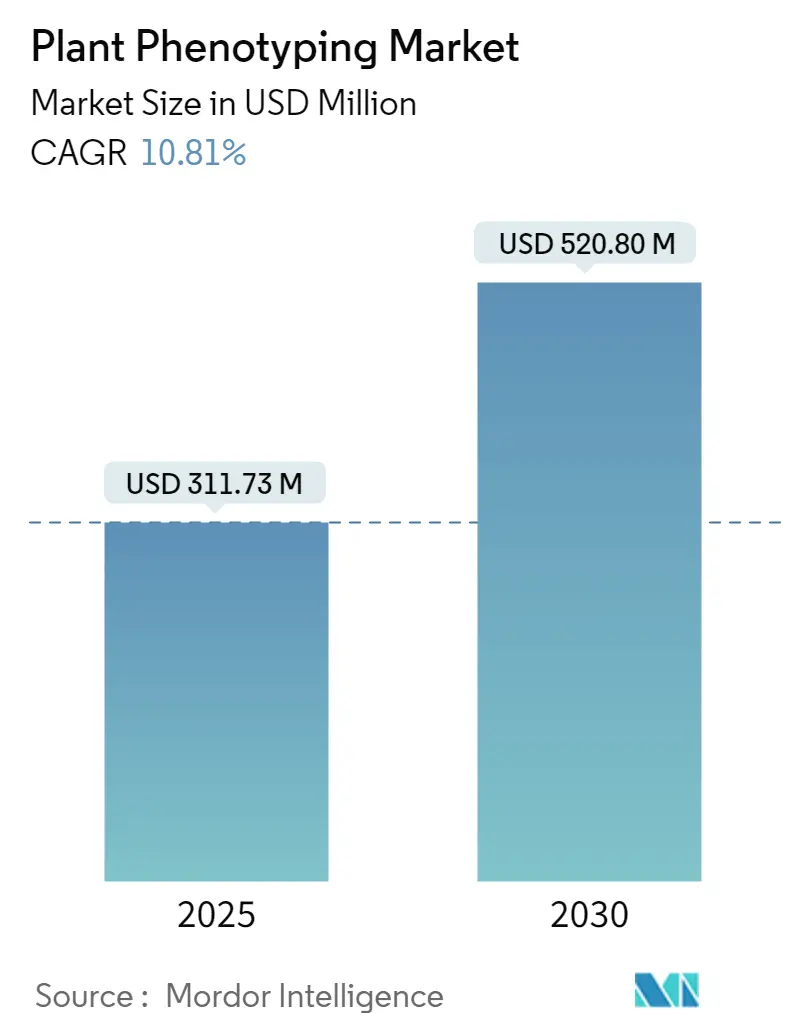
Plant Phenotyping Market Analysis by Mordor Intelligence
The Plant Phenotyping Market size is estimated at USD 311.73 million in 2025, and is expected to reach USD 520.80 million by 2030, at a CAGR of 10.81% during the forecast period (2025-2030).
- In recent years, global challenges related to hunger and food insecurity have alarmingly intensified, driven by the pandemic, conflicts, climate change, and widening inequalities. The United Nations projections indicate that by 2030, over 600 million individuals could face hunger, underscoring the daunting challenge of meeting the zero hunger target. Major global organizations, including the United Nations, the Food and Agriculture Organization, and the World Bank, are actively investigating technologies to address food shortages. As a result, the market for these technologies, such as plant phenotyping, is set for substantial growth, given their crucial role in integrating new techniques to sustain production levels.
- Wearable sensors are revolutionizing crop health analysis. Serving as advanced data collection tools, these sensors present a viable solution to numerous agricultural challenges. By employing a contact measurement mode, they enable real-time monitoring of plant traits and their environments. Although early adopters have made strides in tracking plant growth and microclimates, the vast potential of wearable sensors in plant phenotyping is still largely uncharted, signaling a significant opportunity for growth in the plant phenotyping market.
- Rapid advancements in robotics and artificial intelligence (AI) are finding increasing applications in plant phenotyping and precision agriculture. These technologies are pivotal in intelligent plant photoprotection, soil preservation, reducing chemical usage and labor costs, and ensuring food security. Recently, researchers have made notable progress in crafting a variety of AI techniques, sensor technologies, and agricultural robots tailored for planting and monitoring. Today's AI capabilities enable swift and convenient measurement of a broad spectrum of plant morphological, physiological, and chemical parameters. Furthermore, the combination of AI and robotics facilitates real-time plant monitoring, be it in complex field scenarios or controlled environments. As a result, the market is set for significant growth, fueled by this AI integration.
Global Plant Phenotyping Market Trends and Insights
Rising Acreage of Genetically Modified Crops
- The UK's Regulatory Horizons Council, in its Report on Genetic Technologies, emphasizes a significant benefit: farm workers, particularly smallholder farmers, have faced fewer pesticide poisonings due to the reduced pesticide use associated with GM crops. The report highlights that several countries, India included, have gained economic advantages and healthier populations through the adoption of genetically modified (GM) crops. In India, the report notes that insect-resistant GM (Bt) cotton has led to a 50-to-70 percent reduction in pesticide applications, resulting in significant health benefits. Consequently, as acceptance of GM crops grows in mitigating pesticide use and the demand for plant phenotyping has surged, given its role in testing and developing GM crops.
- According to statistics from the International Service for the Acquisition of Agri-biotech Applications, 2023 witnessed a record 206.3 million hectares globally dedicated to GM crops, marking a 1.9% increase from 2022. Cultivation spanned 27 countries, with eleven distinct GM crops. Soybeans lead the GM crop cultivation area, being planted on 100.9 million hectares. Following closely was maize, covering 69.3 million hectares, and cotton, which occupied 24.1 million hectares. The U.S., Canada, India, Brazil, and Argentina took the lead in GM crop acreage, enjoying more lenient regulations than their European counterparts. This trend indicates these nations' intensified focus on GM crop development, particularly using plant phenotyping technologies, in the future.
- Governments are actively revising regulations to integrate genetically modified crops into the agricultural ecosystem. In April 2023, China's Ministry of Agriculture and Rural Affairs (MOA) granted its inaugural safety certificate for plant gene editing, specifically for a high oleic acid soybean developed by Shandong BellaGen Biotechnology Co. Notably, BellaGen stands as China's pioneer in launching industrial-scale plant gene editing. Earlier, on March 20, 2023, Japan's Ministry of Health, Labour, and Welfare, alongside the Ministry of Agriculture, Forestry, and Fisheries, approved a high-starch maize variety. This marked Japan's fourth genome-edited food product, exempted from regulations typically imposed on genetically engineered crops. Such regulatory relaxations from governments are poised to boost the market for plant phenotyping products and services.
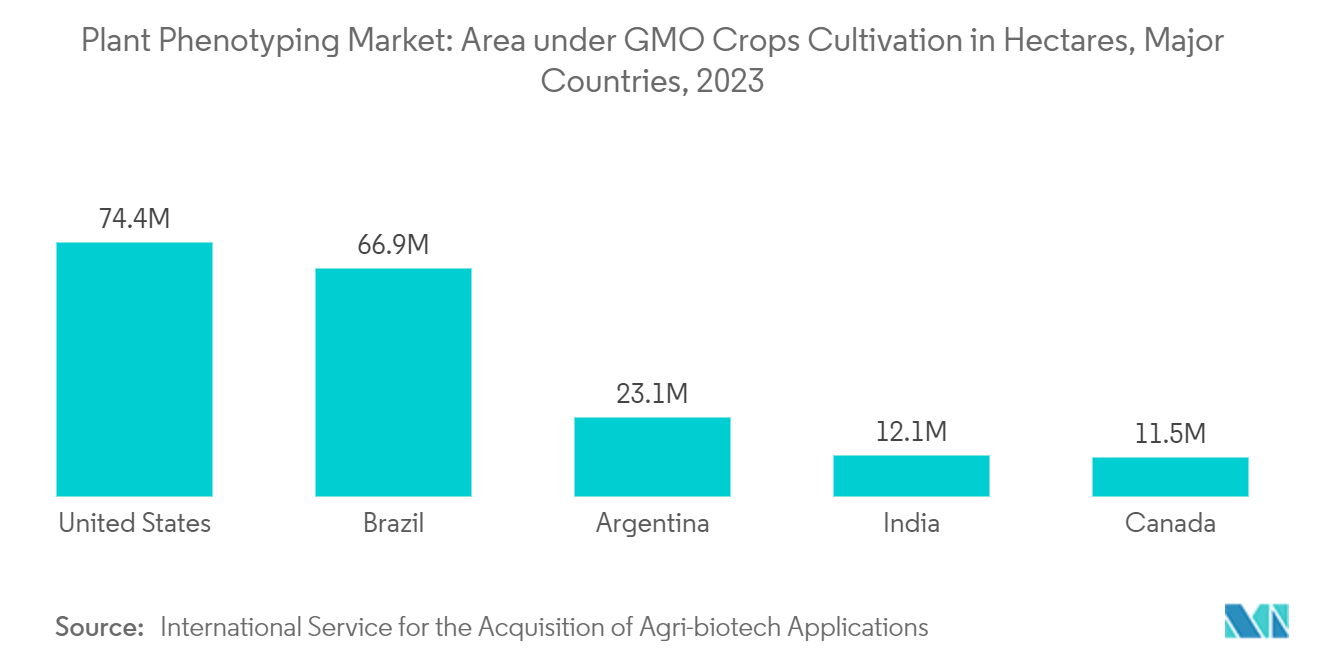
Europe Dominates the Phenotyping Market
- Europe has emerged as a frontrunner in plant phenotyping, with numerous institutions under the European Plant Phenotyping Network (EPPN) gaining global recognition. These institutions are pivotal in advancing and applying plant phenotyping methods, including pioneering new technologies and refining data management and analysis tools. Given this momentum, the European research landscape is poised not only to sustain but also to amplify its dominance in this crucial technology. As a result, the region is expected to witness significant market saturation in the coming years.
- The European Union is funding research projects focused on developing new technologies for plant phenotyping. For instance, the PhotoBoost initiative, set to conclude in 2025, aims to significantly enhance the efficiency of photosynthesis in plants. This optimization is leveraging a multidisciplinary approach, incorporating computational biology, metabolic modeling, systems biology, enzyme and pathway engineering, synthetic biology, and multigene transformation, specifically targeting two major C3 crops: potato and rice. The PhotoBoost strategy not only introduces new methods but also refines existing ones to boost photosynthetic efficiency.
- Moreover, the European region hosts key players in the plant phenotyping market, solidifying its position as the dominant market, especially in terms of phenotyping research and services. Increasing research activities across European nations are boosting awareness, subsequently propelling the market for plant phenotyping products and services.
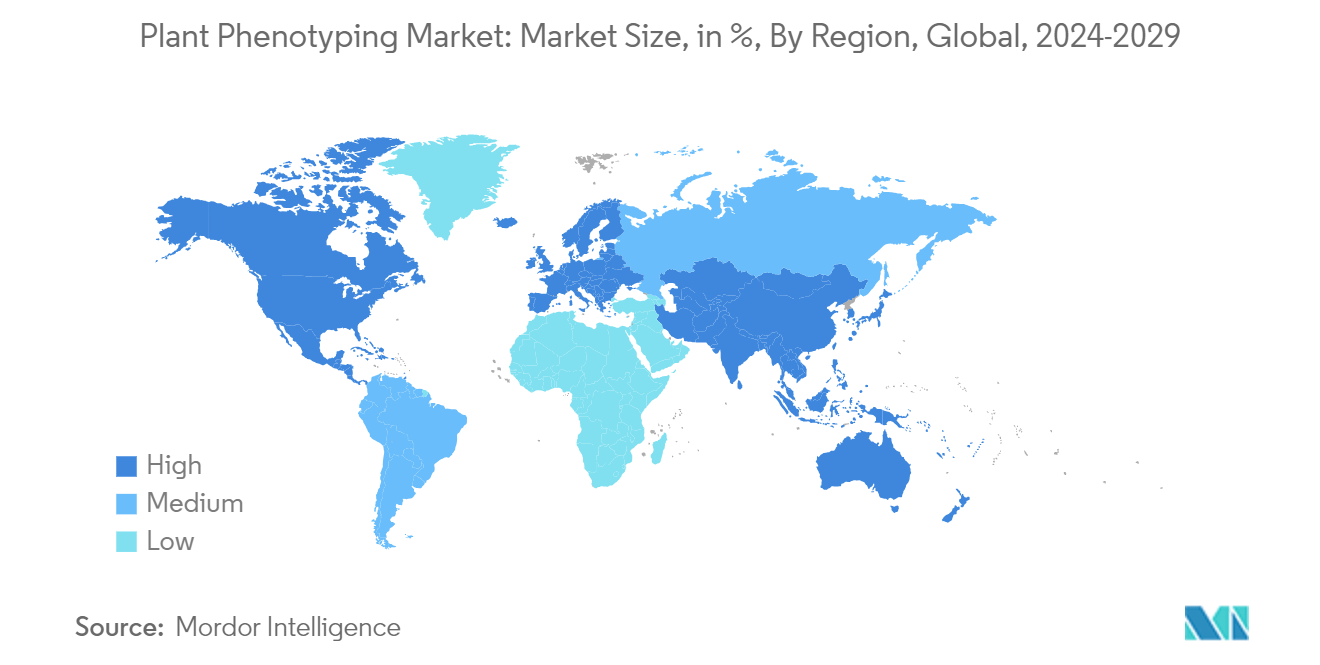
Competitive Landscape
The Plant Phenotyping market is dominated by a handful of major players. Key players include Heinz Walz GmbH, Keygene, PSI (Photon Systems Instruments), Nynomic AG (LemnaTec GmbH), and Qubit Systems. The market is highly competitive, with companies ramping up investments in developing novel products and solutions. However, the market remains limited to a select few players, primarily due to the substantial research and development costs associated with creating innovative plant phenotyping products and solutions.
Plant Phenotyping Industry Leaders
-
Heinz Walz GmbH
-
Keygene
-
PSI (Photon Systems Instruments)
-
Nynomic AG ( LemnaTec GmbH)
-
Qubit Systems
- *Disclaimer: Major Players sorted in no particular order
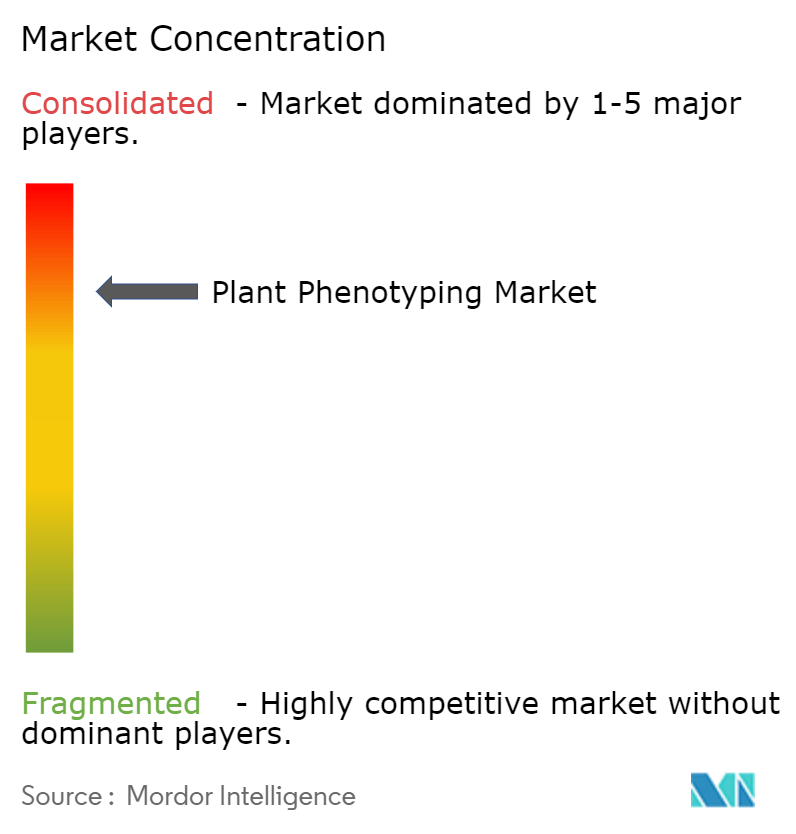
Recent Industry Developments
- July 2024: Heinz Walz GmbH partnered with Plant Science Brasil Ltda to establish a distribution partnership in Brazil. This alliance aims to serve researchers and clients focused on plant physiology, soil physics, and environmental monitoring.
- September 2023: Crystal Crop Protection Limited and KeyGene signed a Memorandum of Understanding, broadening their technology partnership into a multi-year strategic research collaboration. This initiative will leverage KeyGene's proprietary innovative breeding technologies for enhanced crop improvement.
Global Plant Phenotyping Market Report Scope
Plant phenotyping is an emerging scientific technique that links genomics with plant agronomy. In the process of phenotyping, the functional plant body or phenotype is formed during plant growth and development from the dynamic interaction between the genetic background or genotype and the physical world in which plants develop or the environment. The Plant Phenotyping Market is Segmented Into Products (Equipment, Software, and Sensors, Services), and Geography (North America, Europe, Asia-Pacific, South America, and Africa). The Report Offers Market Size and Forecasts for the Market in Terms of Value (USD) for all the Above Segments.
| Equipment | Automation Type | Manual |
| Semi-Automated | ||
| Fully Automated | ||
| Application | High-Throughput Screening | |
| Trait Identification | ||
| Photosynthetic Performance | ||
| Morphology and Growth Assessment | ||
| Other Applications | ||
| Analysis System | Image Analysis Systems | |
| Multispectral Scientific Cameras | ||
| Canopy Analysis Systems | ||
| Fluorometers | ||
| Others | ||
| Site | Laboatory | |
| Green House | ||
| Field | ||
| Platform | Conveyor-Based/Modular Systems | |
| Bench-Based Systems | ||
| Handheld/Portable Systems | ||
| Drones | ||
| Softwares | Image Analysis | |
| Data Acquisition | ||
| System Control | ||
| Other Softwares | ||
| Sensors | Image Sensors | |
| NDVI Sensors | ||
| Temperature Sensors | ||
| Other Sensors | ||
| Services | Measurement Acquisition & Data Analysis | |
| Statistical Analysis | ||
| North America | United States |
| Canada | |
| Mexico | |
| Rest of North America | |
| Europe | Germany |
| United Kingdom | |
| France | |
| Italy | |
| Russia | |
| Spain | |
| Rest of Europe | |
| Asia Pacific | China |
| Japan | |
| India | |
| Australia | |
| Rest of Asia-Pacific | |
| South America | Brazil |
| Argentina | |
| Rest of South America | |
| Africa | South Africa |
| Rest of Africa |
| Type | Equipment | Automation Type | Manual |
| Semi-Automated | |||
| Fully Automated | |||
| Application | High-Throughput Screening | ||
| Trait Identification | |||
| Photosynthetic Performance | |||
| Morphology and Growth Assessment | |||
| Other Applications | |||
| Analysis System | Image Analysis Systems | ||
| Multispectral Scientific Cameras | |||
| Canopy Analysis Systems | |||
| Fluorometers | |||
| Others | |||
| Site | Laboatory | ||
| Green House | |||
| Field | |||
| Platform | Conveyor-Based/Modular Systems | ||
| Bench-Based Systems | |||
| Handheld/Portable Systems | |||
| Drones | |||
| Softwares | Image Analysis | ||
| Data Acquisition | |||
| System Control | |||
| Other Softwares | |||
| Sensors | Image Sensors | ||
| NDVI Sensors | |||
| Temperature Sensors | |||
| Other Sensors | |||
| Services | Measurement Acquisition & Data Analysis | ||
| Statistical Analysis | |||
| Geography | North America | United States | |
| Canada | |||
| Mexico | |||
| Rest of North America | |||
| Europe | Germany | ||
| United Kingdom | |||
| France | |||
| Italy | |||
| Russia | |||
| Spain | |||
| Rest of Europe | |||
| Asia Pacific | China | ||
| Japan | |||
| India | |||
| Australia | |||
| Rest of Asia-Pacific | |||
| South America | Brazil | ||
| Argentina | |||
| Rest of South America | |||
| Africa | South Africa | ||
| Rest of Africa | |||
Key Questions Answered in the Report
How big is the Plant Phenotyping Market?
The Plant Phenotyping Market size is expected to reach USD 311.73 million in 2025 and grow at a CAGR of 10.81% to reach USD 520.80 million by 2030.
What is the current Plant Phenotyping Market size?
In 2025, the Plant Phenotyping Market size is expected to reach USD 311.73 million.
Who are the key players in Plant Phenotyping Market?
Heinz Walz GmbH, Keygene, PSI (Photon Systems Instruments), Nynomic AG ( LemnaTec GmbH) and Qubit Systems are the major companies operating in the Plant Phenotyping Market.
Which is the fastest growing region in Plant Phenotyping Market?
Asia Pacific is estimated to grow at the highest CAGR over the forecast period (2025-2030).
Which region has the biggest share in Plant Phenotyping Market?
In 2025, the Europe accounts for the largest market share in Plant Phenotyping Market.
What years does this Plant Phenotyping Market cover, and what was the market size in 2024?
In 2024, the Plant Phenotyping Market size was estimated at USD 278.03 million. The report covers the Plant Phenotyping Market historical market size for years: 2019, 2020, 2021, 2022, 2023 and 2024. The report also forecasts the Plant Phenotyping Market size for years: 2025, 2026, 2027, 2028, 2029 and 2030.
Page last updated on:
Plant Phenotyping Market Report
Statistics for the 2025 Plant Phenotyping market share, size and revenue growth rate, created by Mordor Intelligence™ Industry Reports. Plant Phenotyping analysis includes a market forecast outlook for 2025 to 2030 and historical overview. Get a sample of this industry analysis as a free report PDF download.
